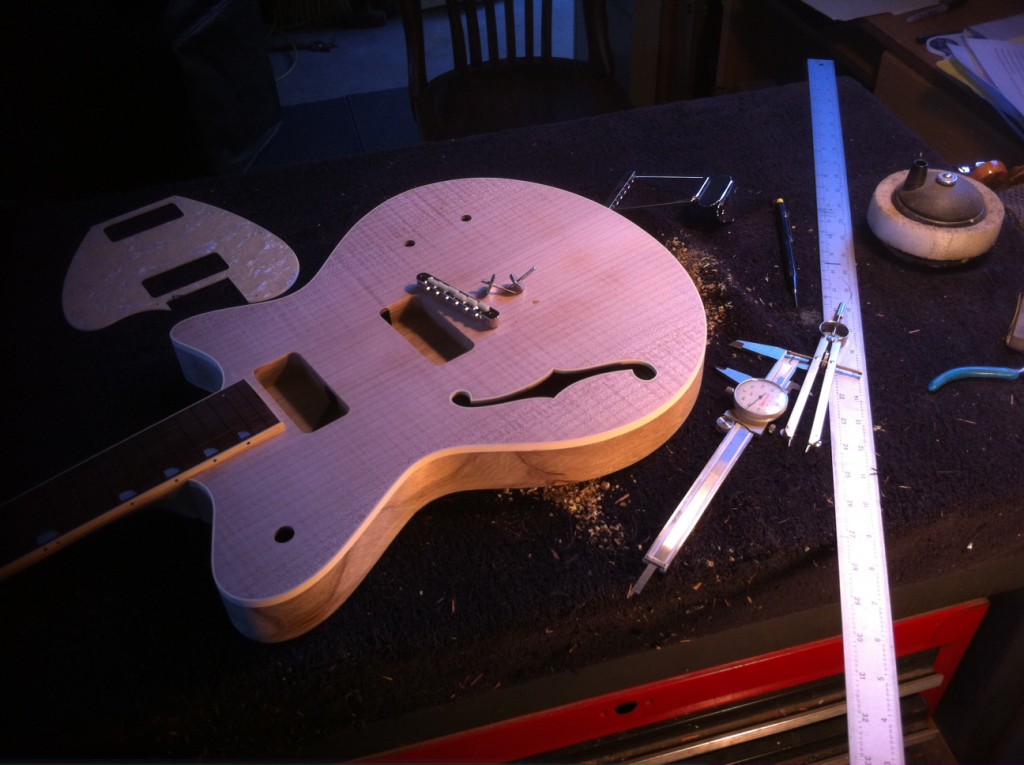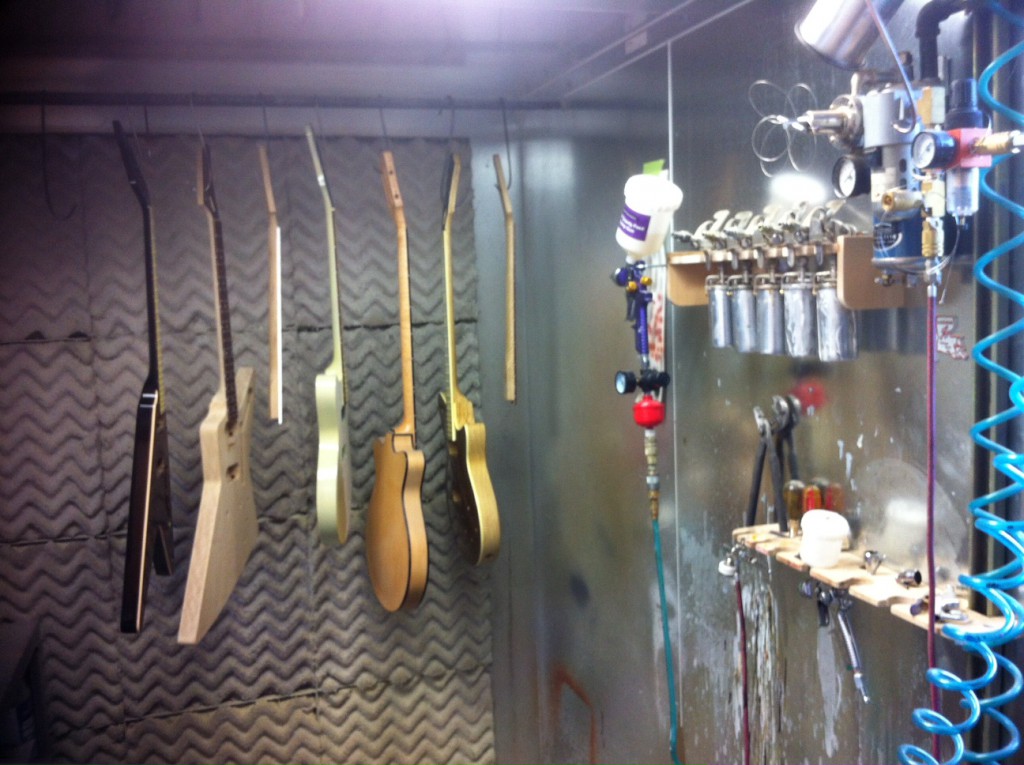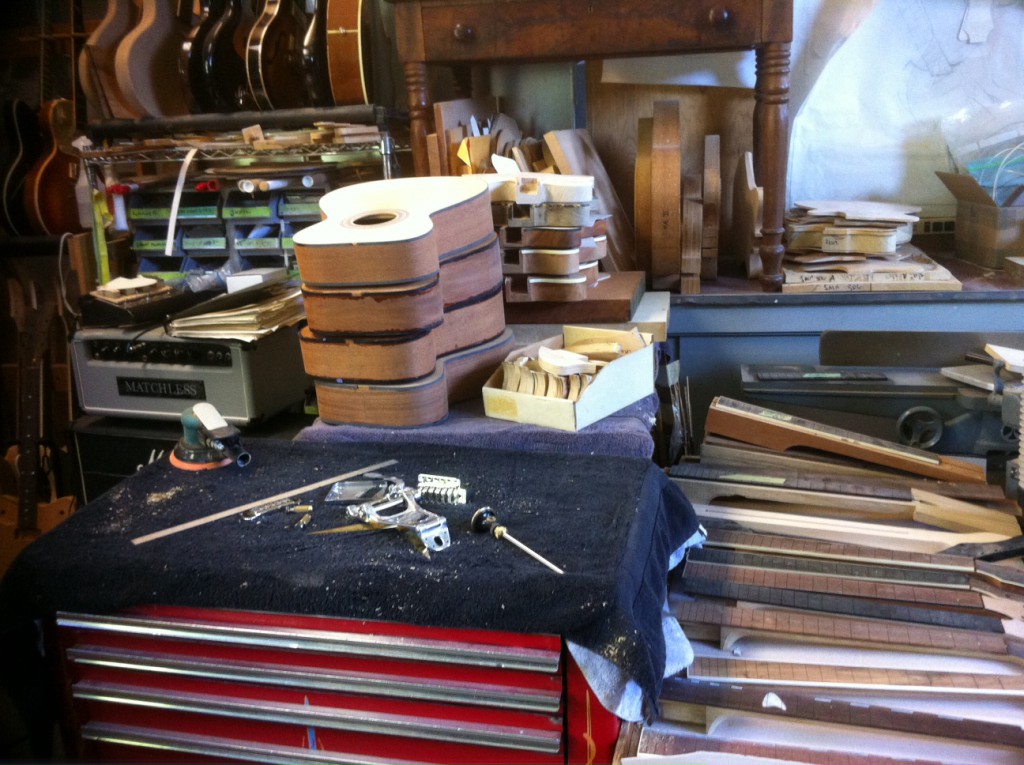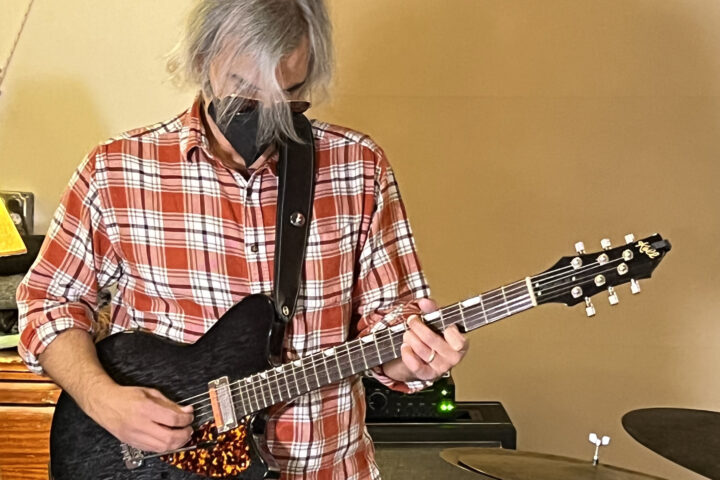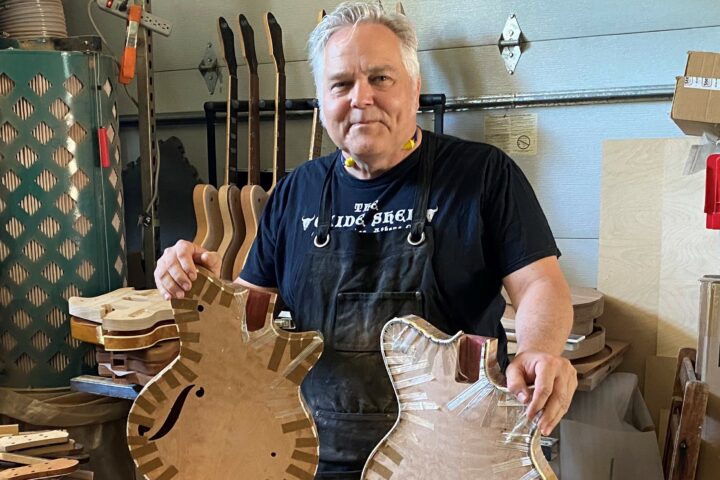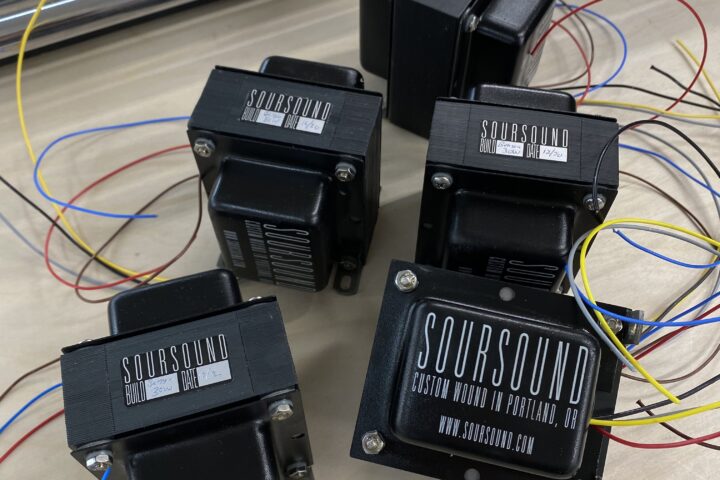The guitar bug hit luthier Saul Koll at an early age. When he was just 12, he discovered Irving Sloan’s legendary book, Classic Guitar Construction, at a Southern California library. In the ‘80s, he was a founding member of rock group the Charms. By 1990, he founded the Koll Guitar Company. Today, Koll is primarily known for his Glide line of electric guitars (now built by Premier Builders Guild), but he’s equally at home making archtops, basses, Teles and one-off creations. On the day we called Koll at his Portland, Oregon workshop for this week’s Bench Press column, he was hard at work on several guitars.
Fretboard Journal: What is on your bench right now?
Saul Koll: Right now, I’ve got a couple things. I’ve got an all-Korina Duo Glide. I’m using some TV Jones’ Filter’Trons and it’s got a Brazilian rosewood fingerboard. I’m just drilling for the Tune-o-matic bridge right now. On this one, the guy wanted a Tune-o-matic rather than the usual Bigsby that I use, and a trapeze tailpiece. So, I was laying that out. He just wanted a different look and a different feel, maybe like an ES-330 or a 335 – those mid-‘60s ones that have the trapeze rather than the stoptail.
I tend to do things in small batches. So basically I’ve got a line of instruments that I’m doing all of the bridge location and drilling for. All of these guitars have the necks set and the frets are in. This is all before finishing. One of the last things I do before spraying them is drill for the hardware. That way, all of the math and geometry is done before it goes into paint, ‘cause it’s a lot harder to change it after that!
So, that’s what I’m up to. There are a few here in front of me that are all Tune-o-matic and Bigsby’d and have the typical hardtail kind of bridges. And then behind that I have a batch of instruments that require Stratocaster-style routing with the spring cavity and all that stuff. Meanwhile, I’m jumping into the paint booth and putting coats of finish on things.
I’m a one-person shop here. So I do small batches of things. Maybe this day it’ll be a fret day, so I’ll work on frets on everything. Or this day will be a routing day, where I’ll do a bunch of routing. That way I can maximize tool setups – I can set up to cut a specific thing, and I’ll cut those things. It’s not quite an assembly line, it never will be – or never has been – but I’m moving station-to-station, pretty much. And the guitars come out the other end periodically.
FJ: And what do those final steps look like?
SK: I’ll do everything I have to do to a guitar, string it up, wire it up, set it up and then I’ll let it sit. Then I’ll come back the next day when I’m fresh, and I’ll play that guitar for a while, just to make sure that I didn’t miss anything because of fatigue. I’ll just sit and play it through an amplifier for a half hour or an hour. If any setup changes, or if the wood changes because it’s under tension now, I can address those things.
Ideally, I like to have a guitar strung up and set up in the shop for a couple days before I box it up and deliver it. Sometimes I’ll work pretty late at night and I’ll finish up a guitar and for whatever reason, at the end of day, I’m just too exhausted to feel the nuance, or hear what I need to hear out of it, so I have to come back. I have to come back fresh after a good night’s sleep and put it up on the bench and encounter it as a new guitar and really check it out for what it is, rather than, “Geez, that last that last step really exhausted me.”
FJ: So at any time you have both guitars that are just getting built alongside instruments that are basically done?
SK: Yeah, I have guitars at every stage, at all times. I’ve got everything from a stack of lumber to things that are strung up that just require my final approval. It’s kind of a nonlinear way of working, I suppose, where I’m trying to move from this to that but it’s a way I like to work. It keeps everything interesting and fresh.
FJ: Some of your instrument designs are built in California by the Premier Builders Guild. Can you talk a little bit about how that started?
SK: Three or four years ago I was approached by Michael Bernstein, who was a guitar aficionado. He loved instruments and had many. He had met some builders that he liked, and wanted to figure out if there was a better way to market some of these smaller luthiers.
He talked to a variety of smaller manufacturers – Dennis Fano, myself, Tone King Amplifiers, a few others – and set up this co-op where the business side would happen in a certain centralized location and we would have the ability to do group buys of materials and that sort of thing. It’s a new business so its structure changed over time, and some people have come and some people have left. In my situation, what I did with them was license my Glide series. The Glide series is a series of guitars that I designed in the early ‘90s, and it’s been basically my breadwinner for all this time.
I had been making this guitar – the semi-production model – for 10 or 15 years at that point. When they approached me with this idea, I thought, “You know what, this is really interesting.” I knew where my strengths are. My strengths are not in managing people. I like to work alone. Working in that way, there’s always going to be a cap, as far as how many dealers I can support, how many instruments I can put out, and that kind of stuff.
When Premier Builders Guild approached me, here was an opportunity to give the brand and the line an opportunity to hit more dealers. Their main engineer was Gene Baker, who has been a friend of mine for a long time, and a super respected builder. I thought, “If Gene Baker is involved and he’s in charge of getting my guitars made through my specs, that sounds like a pretty interesting situation.”
I can expand my reach, get the name recognition out there a little bit a more – at some more shops around the world – meanwhile I can focus on my more custom one-off, weirdo guitars. I’m comfortable doing maybe 20-30 guitars a year, which hardly supports one dealer, really. This way the Glide series continues on through a great outfit, and I continue my thing. It’s been working out great.
[Editor’s Note: If you’re a builder and have a fun project going on, drop us a line. We’d love to hear about it.]
